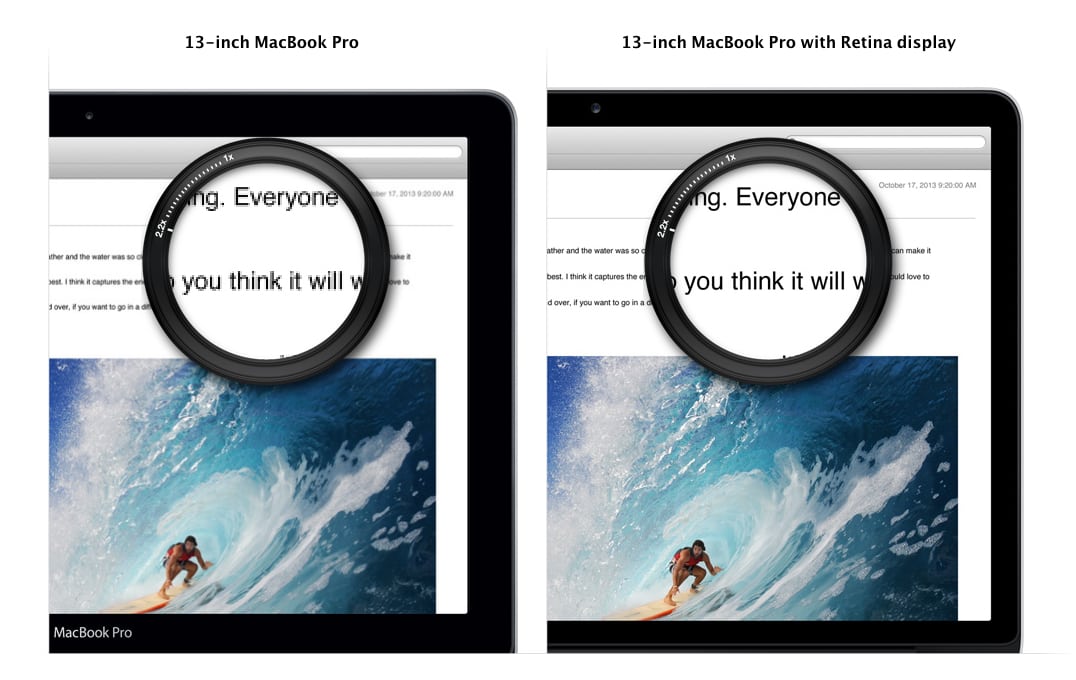

#RETINA DISPLAY PRO#
The Retina display has since expanded to most Apple product lines, such as Apple Watch, iPhone, iPod Touch, iPad, iPad Mini, iPad Air, iPad Pro, MacBook, MacBook Air, MacBook Pro, iMac, and Pro Display XDR, some of which have never had a comparable non-Retina display. The goal of Retina displays is to make the text and images being displayed more crisp. The advantage of this equation is that the CPU "sees" a small portion of the data and calculates the relative positions of each element, and the GPU renders these elements with high quality assets.
#RETINA DISPLAY PLUS#
The scale factor is tripled for devices with even higher pixel densities, such as the iPhone 6 Plus and iPhone X. In simpler words, it is one logical pixel corresponds to four physical pixels. The Retina display debuted in 2010 with the iPhone 4 and the iPod Touch (4th Generation), and later the iPad (3rd generation) where each screen pixel of the iPhone 3GS, iPod touch (3rd generation), iPad 2 was replaced by four smaller pixels, and the user interface scaled up to fill in the extra pixels. The Canadian application cited a 2010 application in Jamaica. The applications were approved in 20 respectively. Apple has registered the term "Retina" as a trademark with regard to computers and mobile devices with the United States Patent and Trademark Office and Canadian Intellectual Property Office. and have a higher pixel density than their traditional displays.
#RETINA DISPLAY SERIES#
It’s possible to buy a 13.3in laptop at that resolution to give a better 166ppi, but it’s a rare option offered by a select few manufacturers.The Retina display is a branded series of IPS LCD and OLED displays by Apple Inc. By contrast, a 15.4in laptop display with today’s most common 1,366 x 768 resolution has a density of 102ppi even at 1,920 x 1,080, it’s still only at 143ppi. In fact, the iPhone 4 and 4S have a 326ppi display, the latest iPad is 264ppi and the new MacBook Pro is 220ppi, all of which – given the variations in viewing distance – meet Jobs’ apparent requirement of invisible pixels with 20/20 vision. Instead, 300ppi is safely beyond the 286ppi capability of 20/20 vision from that distance, so for most people Jobs was right: the individual pixels are indiscernible. “There’s a magic number right around 300ppi,” he said, “that when you hold something around 10 to 12in away from your eyes is the limit of the human retina to differentiate the pixels.” There was disagreement at the time about the claim, since it falls some way short of the resolve of perfect vision – but few people have perfect vision. As screens become larger, so too does the distance from which they tend to be viewed to have the same perceived sharpness, a smartphone in the hand must have a higher pixel density than a laptop on a desk.ĭuring Apple’s 2010 unveiling of the first Retina display on the iPhone 4, Steve Jobs announced a loose figure for smartphones. If that statement sounds vague, that’s because it isn’t as simple as having a golden number to aim for. In Apple’s own words, on a Retina display the “pixel density is so high your eyes can’t discern individual pixels”. If you know the resolution and size of a screen, you can calculate the number of pixels per inch (ppi) it has, where a higher density makes each pixel finer and the overall image sharper. In most laptop displays, that would be the most interesting fact, but few could argue that’s the chief selling point of the MacBook Pro: the more important factor is pixel density. The entire display assembly is an LCD panel.” That’s why the panel is so thin, allowing Apple to trim down the MacBook Pro. As the teardown experts at iFixit explain: “Rather than sandwich an LCD panel between a back case and a front glass, Apple used the aluminium case itself as the frame for the LCD panel and used the LCD as the front glass.

This is because it’s constructed in a different way to standard LCD panels. First, it’s glossy, but without the usual feel of looking at a reflective pane of glass. The MacBook Pro’s Retina display looks almost paper-like, and that’s down to two key design factors.


 0 kommentar(er)
0 kommentar(er)
